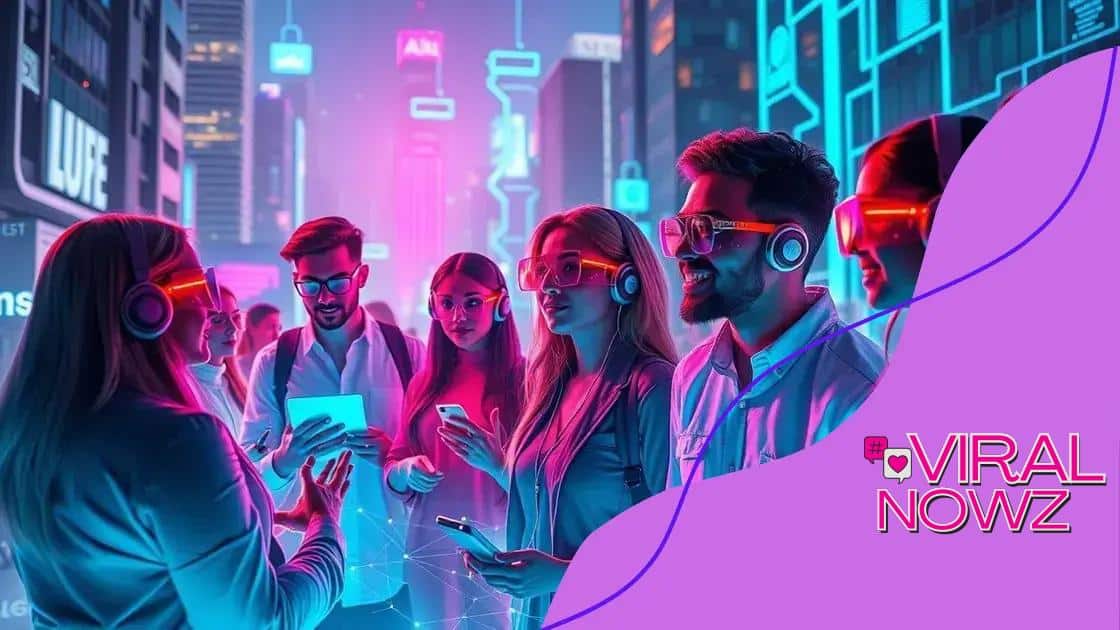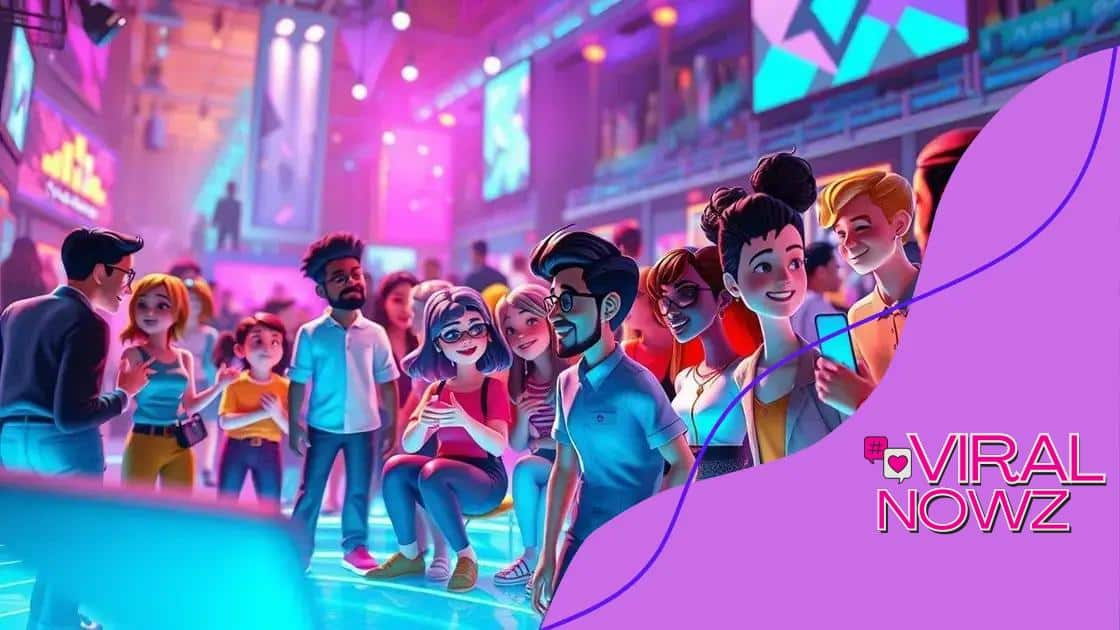The metaverse and its influence on social networking

The metaverse is reshaping social networking by offering immersive environments, personalized experiences, and enhanced user interactions, allowing users to connect deeper and engage in a vibrant digital landscape.
The metaverse and its influence on social networking is a topic gaining traction as technology evolves. Imagine connecting with friends in a digital world where reality blurs; that’s the metaverse for you! Let’s explore its significance.
Understanding the metaverse: A brief overview
The metaverse is an evolving concept that represents a virtual universe where people can interact, work, and play. It combines the physical and digital realms, creating immersive experiences. In simple terms, imagine a space where reality blends with virtual elements, allowing users to engage in real-time activities.
Features of the Metaverse
Understanding the metaverse involves recognizing its core features. It includes environments that promote social interaction, digital economies, and user-generated content. Users navigate the metaverse through digital avatars, which serve as their digital representation.
- Immersive Experiences: Users feel present in the environment, regardless of their physical location.
- Interoperability: Different platforms connect seamlessly, allowing for a broader experience.
- User Ownership: Individuals can own, buy, and sell digital assets within this world.
- Social Interaction: Tools and features promote connections and collaborations with others.
Another aspect to consider is the variety of activities possible in the metaverse. It can host social gatherings, business meetings, gaming, and educational opportunities. For instance, imagine attending a concert held in a virtual venue where fans can experience it together, regardless of distance. The possibilities are endless.
The Role of Avatars
Avatars are crucial in the metaverse as they represent users. They enable personalized interaction, reflecting individual styles and preferences. The designs can range from realistic to purely imaginative, fostering creativity. Avatars not only interact with other users but also navigate the environment, as each person shapes their journey through choices and experiences.
The metaverse’s potential continues to grow, captivating technology enthusiasts and everyday users alike. As it develops, understanding its facets becomes essential for participation and digital citizenship.
Key features of the metaverse influencing social networks
The key features of the metaverse have a profound effect on social networks today. One major element is its immersive experience. Users can feel as if they are truly present with others, which changes the way they connect. Instead of simply liking a post, they can engage in real time, creating a deeper connection.
Immersive Environments
Immersive environments allow users to engage with stunning visuals and realistic interactions. The idea is to create virtual spaces that feel as vibrant as the real world. Everything from virtual concerts to collaborations in digital workspaces showcases how this feature promotes social interaction. People can join together in ways that were previously impossible.
- 3D Interaction: Users navigate in three dimensions, enhancing the experience.
- Engagement Tools: Features like voice chat and gestures make interactions feel life-like.
- Shared Experiences: Events and activities become more inclusive and engaging.
Another aspect is interoperability. This feature ensures different platforms can connect and users can move fluidly across them. Imagine sharing a virtual space with friends from different apps without losing any interaction quality. It encourages more sharing and connectivity.
The digital economy is also a standout feature. In the metaverse, users can create, buy, and sell virtual goods. This economy empowers users and businesses, emphasizing the importance of community engagement. For instance, artists can sell their work as NFTs, reaching audiences globally while maintaining ownership.
User-Generated Content
User-generated content becomes a foundation for the metaverse. Users themselves contribute to building the spaces and activities, enhancing creativity and interaction. This makes the environment more vibrant and filled with personal touches from the community. Everyone contributes uniquely, which enriches connections among users.
The blend of these features within the metaverse reshapes social networks and offers a glimpse into the future of online interactions. The interconnectedness fosters unique spaces for communication, collaboration, and creativity.
The role of avatars in digital social interactions

Avatars play a crucial role in digital social interactions within the metaverse. These digital representations allow users to express themselves in unique ways, shaping the experience and connection with others. When users create avatars, they choose features, styles, and accessories, enabling a personal touch in a virtual world.
Personalization of Avatars
Avatars can reflect individual identities and preferences, making interactions more engaging. They allow users to show off their personality and interests, making social participation more relatable. Users might design their avatars to mirror their appearance or create entirely fictional characters that embody certain traits.
- Reflecting Identity: Avatars can express cultural and personal backgrounds.
- Enhancing Engagement: A well-designed avatar can boost confidence during interactions.
- Creative Expression: Users can customize looks with unique outfits and features.
Moreover, avatars facilitate connection. When users interact through avatars, they often feel more comfortable sharing thoughts and ideas. This sense of presence helps in building friendships and communities. In various social scenarios, like gaming or virtual meetups, avatars provide a layer of anonymity, allowing more freedom in expression.
Interaction Dynamics
The dynamics of avatar interactions can significantly influence the overall experience. For instance, users can perform actions like waving, dancing, or gesturing, fostering a lively atmosphere. These actions create a sense of presence, making digital environments feel more like real-life gatherings.
As avatars interact within shared spaces, they create unique social environments where individuals can connect over common interests. This highlights how essential avatars are to building community in the metaverse. Users share experiences, attend events, and collaborate on projects, all while being represented by their avatars.
The role of avatars in digital social interactions extends to forming relationships and collaborations that transcend geographical boundaries. This makes social networking in the metaverse not only fun but also meaningful.
How companies are leveraging the metaverse for networking
Companies are increasingly leveraging the metaverse for networking opportunities. This space allows businesses to interact with clients and partners in immersive environments unlike traditional platforms. Imagine attending virtual conferences or meetings that feel almost real, rather than just staring at a screen.
Virtual Events and Conferences
Hosting virtual events is becoming a popular way for companies to engage audiences. These events can range from product launches to trade shows, offering interactive elements that strengthen connections. Attendees can network in a shared environment, discuss ideas, and showcase products face-to-face, even when they are miles apart.
- Networking Areas: Virtual booths and networking lounges facilitate conversations.
- Interactive Presentations: 3D elements and live demos enhance engagement.
- Global Reach: Attendees from around the world can join without travel costs.
In addition to events, companies are utilizing collaboration spaces in the metaverse to work on projects. These spaces allow teams to interact organically as if they were in a physical office. Employees can brainstorm, share ideas, and develop solutions together while feeling present in a virtual workspace.
Building Stronger Relationships
The metaverse helps in building stronger relationships with clients. Businesses can host personalized experiences that provide value, such as virtual consultations and targeted demonstrations. These interactions can help in understanding client needs better and fostering loyalty.
Moreover, companies can create unique content tailored to their audience. For example, businesses might create branded virtual worlds or experiences that highlight their culture and values. This enhances the brand image and makes sure customers feel more connected to the company.
As companies explore these innovative approaches, they embrace the future of networking. The metaverse not only pushes the boundaries of traditional engagement but also opens new avenues for collaboration, understanding, and customer loyalty.
Future trends: What’s next for the metaverse and social media?
Future trends in the metaverse and social media point towards exciting innovations. As technology evolves, the integration of augmented reality (AR) and virtual reality (VR) into everyday social interactions will become more seamless. Imagine using AR glasses to view virtual overlays of social media content in the real world while interacting with friends, enhancing both physical and digital experiences.
Enhanced User Experiences
Next, we can expect enhanced user experiences within the metaverse. Developers are focusing on creating environments that feel authentic and engaging. Users might find themselves in virtual cafes or lounges, where they can meet friends and engage in activities as they would in the real world. This shift moves away from passive scrolling to active participation.
- Collaborative Spaces: Rooms designed for group projects and socializing will promote interaction.
- Personalized Content: Platforms will adapt to individual preferences, delivering tailored experiences.
- AI Interaction: Virtual assistants will guide users through these environments, improving navigation.
Social media platforms are also likely to adopt more metaverse features. Users can expect integrated shopping experiences, where they can browse and purchase products in virtual stores while interacting with friends. This merging of content and commerce creates a more dynamic online ecosystem.
Decentralization and User Empowerment
The future may also see a shift towards decentralization within the metaverse. This trend allows users to take control of their data and digital identities. Blockchain technology can provide secure transactions and authentic ownership of virtual assets. As users become more aware of privacy concerns, they will likely demand more transparency and control over their information.
New ways of monetization will emerge, allowing creators to benefit directly from their work. As a result, user-generated content will flourish, leading to unique experiences that reflect diverse perspectives. This autonomy may drive more creativity and innovation in how users connect and share in the metaverse.
As we look ahead, the blending of technology, social interaction, and user agency will redefine how we engage with both the metaverse and social media, creating a vibrant digital landscape.
In conclusion, the metaverse is transforming how we connect, work, and interact online. As we look ahead, we can expect exciting innovations in social media environments. With increased immersion, personalized experiences, and empowered users, the future is bright for digital interactions. The blend of reality and virtual elements will enrich our social engagements, making them more meaningful. Embracing these changes will help us navigate the evolving landscape of the metaverse successfully.
FAQ – Frequently Asked Questions about the Metaverse and Social Media
What is the metaverse?
The metaverse is a virtual universe that allows people to interact, work, and play in immersive online environments.
How do avatars enhance social interactions in the metaverse?
Avatars allow users to express themselves personally, facilitating deeper connections and more engaging interactions online.
What trends can we expect in the future of social media and the metaverse?
Future trends include enhanced user experiences, virtual events, personalization, decentralization, and new ways for collaboration.
How can companies benefit from the metaverse for networking?
Companies can host virtual events, create collaborative spaces, and build stronger relationships with clients through immersive interactions.





